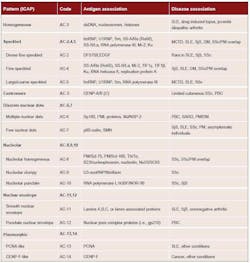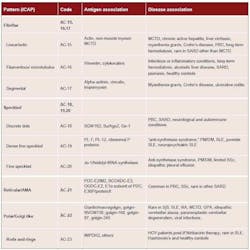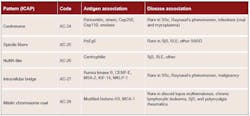Standardization and harmonization in state-of-the-art anti-nuclear antibody testing
Anti-nuclear antibody (ANA) testing is a cornerstone of autoimmune diagnostics. ANAs occur in a variety of autoimmune diseases, including systemic autoimmune rheumatic diseases (SARD), systemic lupus erythematosus (SLE), mixed connective tissue disease (MCTD), Sjögren’s syndrome (SjS), systemic sclerosis (SSc), polymyositis (PM), dermatomyositis (DM) and primary biliary cirrhosis (PBC). Detection and classification of ANA is a major criterion for diagnosing and differentiating these diseases.
ANAs are detected by indirect immunofluorescence assay (IFA) followed by specific confirmatory tests. IFA on human epithelial (HEp-2) cells is the standard for detection of ANAs, as endorsed by the American College of Rheumatology.1 Different types of ANAs give rise to characteristic staining patterns on the HEp-2 cells, depending on the cellular location and properties of the antigenic target. Analysis of the fluorescence pattern enables classification of the antibody or antibodies present in the patient sample, as the cell substrate contains the complete relevant antigen spectrum.
However, ANA testing strategies and result reporting vary greatly among laboratories. The International Consensus on ANA Patterns (ICAP) was released in 2015 with the goal of harmonizing the nomenclature and interpretation of ANA results.2,3 Additionally, the use of automation solutions and computer-aided microscopy has significantly increased the level of standardization in laboratories. This article reviews these latest advances and highlights the benefits for diagnostic laboratories.
Overview of ICAP classification tree
The umbrella term ANA is, for historical reasons, used to refer to all cellular antibodies that are detected on HEp-2 cells. The ICAP classification identifies three major fluorescence patterns; nuclear (true ANA), cytoplasmic, and mitotic. Each category is subdivided into groups and subgroups of patterns, creating a classification tree. Each pattern and subpattern is assigned an anti-cell (AC) pattern code, from AC-1 to AC-28. The patterns are additionally designated as competent-level or expert-level reporting, depending on the clinical relevance and ease of recognition. The reporting level is a fluid system, which will be adapted in the future based on feedback from users.
Nuclear patterns (true ANA)
Nuclear patterns are defined as any staining of the HEp-2 interphase nuclei. The nomenclature for nuclear patterns is primarily based on the reactivity observed in the nucleoplasm (for example, homogeneous or speckled) and the nuclear subcomponents that are recognized (for example, centromere or nucleolar). The nuclear patterns are comprised of homogeneous, speckled, centromere, discrete nuclear dots, nucleolar, nuclear envelope, and pleomorphic patterns. Dense fine speckled 70 (DFS70) belongs to the speckled group. The centromere pattern belongs to the discrete nuclear dots, but is given its own grouping due to its characteristic pattern and frequent occurrence in the clinical setting.
The nuclear pattern groups are further divided into subgroups. The classification of the nuclear pattern provides information about the likely target antigens and thus possible disease indications (Table 1). For example, the homogeneous pattern arises from reactions with chromatin components such as double-stranded DNA, histones, and/or nucleosomes. These autoantibodies are associated with SLE, drug-induced lupus, and juvenile idiopathic arthritis. Other nuclear reactions can help clinicians to delimit, for example, MCTD, SjS, SSc, PM, DM, PBC, or other autoimmune diseases. Mixed patterns can occur if more than one autoantibody/pattern is present in the patient sample; for example, autoantibodies to both centromere (nuclear) and mitochondria (cytoplasmic) frequently coexist in PBC.
Cytoplasmic patterns
Cytoplasmic patterns are defined as any staining of the HEp-2 cytoplasm. The nomenclature is primarily based on the reactivity observed in the cytoplasm (for example, fibrillar or speckled) and the cytoplasmic structure that is recognized (for example, rods and rings). The five main cytoplasmic patterns are fibrillar, speckled, reticular/mitochondrion-like (AMA), polar/Golgi-like, and rods and rings. Cytoplasmic autoantibodies of different specificities are found in a range of diseases (Table 2), including MCTD, PM, DM, SLE, SSc, PBC, Crohn’s disease, ulcerative colitis, and myasthenia gravis. As per the ICAP statement, cytoplasmic patterns should now be reported in patient results and no longer considered ANA negative.
Mitotic patterns
Mitotic patterns are defined as patterns that address cell domains strongly related to mitosis. These patterns include centrosomes, spindle fibers with subpattern nuclear mitotic apparatus (NuMA), intercellular bridge, and mitotic chromosome coat. Some mitotic patterns (for example, centrosomes) are not exclusively associated with mitosis, but exhibit very distinctive features in mitotic cells. Mitotic antibodies rarely occur in
diseases such as SSc, SLE, SjS, and Raynaud’s phenomenon (Table 3).
Recent innovations aid standardization
Automation of IFA evaluation increases the consistency among different readers and laboratories and boosts the speed and efficiency of the evaluation procedure. The need for standardization and automation in IFA is tremendous in all fields of autoimmune diagnostics. Manual evaluation of results is both time-consuming and subjective. Automation platforms with harmonized software and hardware components have in recent years contributed enormously to the standardization and simplification of the evaluation process, especially for ANA, but also antineutrophil cytoplasmic antibodies (ANCA) and Crithidia luciliae immunofluorescence test (CLIFT).
Advanced software provides positive/negative classification, pattern recognition, and titer designation. Today’s systems offer fully automated identification of immunofluorescence patterns on HEp-2 cells, including nuclear, cytoplasmic, mitotic, and, importantly, mixed patterns. The recording of tissue substrates, such as liver, kidney, stomach, esophagus, small intestine, heart, and neuronal tissue, is also feasible with a cutting-edge system. It is anticipated that the continued development of automated evaluation systems will lead to even greater standardization of IFA and further improvements in workflow for diagnostic laboratories.
The ICAP initiative has laid the foundation for standardized nomenclature and reporting of ANA test results. It is an ongoing process, which could potentially mature into a global standard, incorporating input from laboratories and clinicians worldwide. A further important contribution to ANA standardization is the increasing use of computer-assisted microscopy by labs. These systems offer fully automated identification of immunofluorescence patterns on HEp-2 cells.
References
- American College of Rheumatology position statement: methodology of testing for antinuclear antibodies. Published January 2009. Updated August 2015.
- Chan EKL, Damoiseaux J, Carballo OG, et al. Report of the first international consensus on standardized nomenclature of antinuclear antibody HEp-2 cell patterns 2014-2015. Front. Immunol. 2015;6:412.
- Chan EKL, Damoiseaux J, de Melo Cruvinel W, et al. Report on the second International Consensus on ANA Pattern (ICAP) workshop in Dresden 2015. Lupus. 2016;25(8):797-804.




